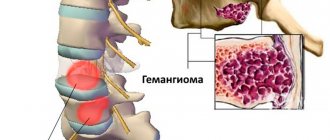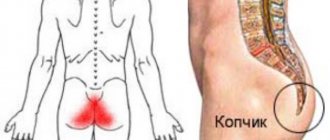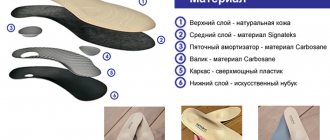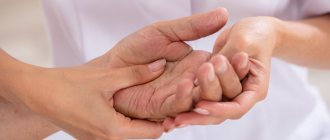Cervical osteochondrosis is a degenerative and dystrophic disease of one of the parts of the spine. As the disease develops, the intervertebral discs in the neck suffer the most, and damage also spreads to the articular surfaces, ligaments, and vertebrae.
Cervical osteochondrosis is a degenerative and dystrophic disease of one of the parts of the spine. As the disease develops, the intervertebral discs in the neck suffer the most, and damage also spreads to the articular surfaces, ligaments, and vertebrae. Treatment of osteochondrosis of the cervical spine depends on the current stage of the disease. The pathology mainly occurs in patients over the age of 30, but cases are also recorded in young people, especially if the person leads an unhealthy lifestyle and is at risk.
The most common symptom is severe pain in the neck, which can spread lower down the spine, move to the upper limbs, and deform into a severe headache. Below we will consider for which symptoms of osteochondrosis of the cervical spine it is better to begin treatment, find out the causes of the disease and the methods that are used to combat the problem.
What is osteochondrosis of the cervical spine?
Cervical osteochondrosis is a degenerative disease of the spine, during the development of which the structure of the connective tissue changes.
The disease is often disguised as a disorder of another type, but timely contact with a specialist allows for timely diagnosis and immediate treatment.
Degenerative changes in the tissues of the cervical spine are most often found in the medical history of people of mature (45-59) and elderly (60-74) age.
Despite this, it is worth noting: in modern society there is a rejuvenation of the disease, which is confirmed by the periodic diagnosis of cervical osteochondrosis in children and adolescents.
It is important that osteochondrosis can occur both in isolation and in combination with damage to other parts, in particular the thoracic, lumbar and sacral.
Treatment
Help before diagnosis
Patients who have very severe pain in the cervical spine should provide functional rest for the neck and avoid head movements, especially turning from side to side. To reduce tension in the neck muscles, it is necessary to take regular breaks from working at the computer or machine. To find out the cause of cervicalgia and select treatment, you should consult a doctor as soon as possible. Until the diagnosis is verified, it is permissible to take analgesics from the NSAID group to relieve excruciating pain. Independent use of warm compresses is prohibited.
Cervical spine massage
Conservative therapy
Medical tactics depend on the cause of the disease and the clinical stage. In the absence of pronounced destructive changes in the spinal column, a combination of drug treatment and physical therapy is sufficient. Physiotherapeutic procedures are prescribed after acute pain in the cervical spine subsides; the most effective are acupuncture, transcutaneous electrical stimulation, ultrasound and electromagnetic methods. For chronic pain syndrome, manual therapy is used. Medicines usually used:
- NSAIDs
. They belong to the first line of drugs for the treatment of acute and chronic pain in the spine. Effectively eliminate pain, reduce inflammatory reactions in joints and soft tissues. To minimize side effects, selective COX-2 inhibitors are preferred. - Local anesthetics
. If the spine hurts unbearably in the cervical region, therapeutic blockades are recommended. Anesthetics in combination with glucocorticosteroids are administered as close to the lesion as possible: into the neck muscles, facet joints, and less often, epidural blockades are performed. - Neurotropic vitamins
. To enhance the analgesic and anti-inflammatory effect of other medications, B vitamins, especially thiamine, are used. The drug inhibits pathological pain impulses and increases the concentration of the most important endogenous analgesic substances. - Anticonvulsants
. These drugs are combined with antidepressants for chronic resistant pain syndrome and psychogenic pain. Additionally, short courses of muscle relaxants are used. For vascular disorders, venotonics are administered.
Surgery
For unstable fractures of the vertebral bodies and arches, surgical reposition of the fragments is indicated with their subsequent stabilization using bone osteosynthesis methods - usually metal plates with transpedicular fixation are installed. For benign spinal tumors, they are removed after preliminary decompression of the brain structures. In the case of spinal osteomyelitis, sequestrectomy is necessary with further restoration of the anatomical integrity of the spinal column.
Surgical treatment methods used for osteochondrosis can be divided into two groups: decompression and stabilization. Decompression surgeries are designed to reduce pressure on the spinal canal and relieve radicular syndrome. For this purpose, laminectomy, endoscopic discectomy, and facetectomy are performed. Stabilizing operations are required when the cervical vertebrae are displaced in the frontal plane and there is a risk of spinal cord damage. Anterior or posterior spinal fusion is performed (fixation of bone structures to ensure their complete immobility).
Causes of cervical osteochondrosis
Today it is impossible to name the exact causes of degenerative processes occurring in intervertebral discs. There is no confirmation that cervical osteochondrosis is an aging phenomenon.
Numerous studies conducted by scientists from different countries have found that osteochondrosis of the cervical spine has predominantly provoking factors.
Among the predisposing causes of the development of osteochondrosis of the neck are:
- low level of activity, inactivity and a predominantly sedentary lifestyle;
- types of work that involve a static load on the cervical spine;
- excess body weight, insufficient level of physical development;
- disruption of connective tissue development processes;
- old spinal injuries;
- spinal deformity, use of insufficiently comfortable pillows and mattresses for rest;
- genetic predisposition.
The vast majority of reasons are in one way or another related to the natural processes of aging of body systems, as well as the likely development of pathologies of bone and cartilage tissue.
Prevention
The main rule of preventive measures is that they must be comprehensive and observed on an ongoing basis. This is the only way they will bring the expected results. Prevention is indicated for people who are at risk.
- Watch your posture. The ideal body position is that the head and back are on the same line. Always make sure that your shoulders are straightened, your stomach is pulled in, and your chest is raised. The gait also plays a role - it should be springy and smooth. Never give yourself any slack; at the initial stage, it is important to discipline yourself; in the future, correct posture will become a habit.
- A properly organized workplace. When working, the shoulders should be relaxed; constant tension in the lumbar girdle has a direct impact on the cervical spine. The basic requirements are a chair with a comfortable back and armrests, a monitor at eye level, a keyboard below the elbows (the angle between the shoulder and forearm is about 120 degrees). While working, make it a habit to take a break every 40-50 minutes and perform basic stretching exercises.
- Correctly adjust the car seat. Many motorists are faced with osteochondrosis of the cervical spine due to the fact that they adjust the driver’s seat not according to the rules, but in a way that is comfortable for them. Correct body position in a chair - the entire spine touches the back, not just the shoulders. It is advisable to purchase special lumbar pillows that will help support the body in the desired position. When driving for a long time, it is important to go out into the streets after 1.5-2 hours and warm up.
- Watch your diet. Problems with the cervical spine are often associated with the fact that the patient eats incorrectly. Dangerous foods that increase the risk of osteochondrosis include: white bread, baked goods, sweets, dishes high in salt and sugar, fried and fatty foods. The main danger is refined sugar - the substance helps wash calcium out of the body. Include legumes and nuts, foods high in protein, seasonal vegetables and fruits in your daily diet. Low-fat fermented milk products - kefir, fermented baked milk, cottage cheese, natural yoghurts - will also have a positive effect. If you have a problem with excess weight, visit a nutritionist.
- Daily physical activity. Treatment of cervical osteochondrosis at home with the help of physical exercise is an excellent preventative against spinal diseases. It is important to do the exercises at an easy pace, without exceeding the permissible load. If you don’t have time for a full set of exercises, make it a rule to take daily walks.
- Massage. Correct techniques restore muscle tone, relieve tension, and trigger metabolic and regenerative processes in the body. It is not necessary to visit specialists; proper massage of the cervical spine can be performed independently.
- Proper sleep. During the day, the intervertebral discs experience increased stress; complete relaxation and rest can only be achieved during night sleep. To prevent osteochondrosis, it is important to organize the right place to sleep and monitor the time (at least 8 hours).
What is the danger of cervical osteochondrosis?
A reduction in the level of mobility and limited flexibility of joints, loss of muscle elasticity and other signs of aging of the body are inevitable, natural processes that accompany a person in ontogenesis.
Annoying pain that occurs when moving much earlier than the natural period of aging often leads to loss of quality of life and even disability.
To determine how to treat cervical osteochondrosis, a professional consultation with your doctor is necessary. In the absence of professional, timely diagnosis and necessary treatment, the disease progresses, which can cause not just a deterioration in well-being, but also serious disruptions to the functioning of the nervous and vascular system.
Main signs and symptoms of cervical osteochondrosis
The structure of the human skeleton, the ability to walk upright and the impressive size of the head have led to the fact that some parts of the spine are the most vulnerable, in particular the cervical one.
Among the striking features of the structure of the cervical spine, it is worth highlighting the presence of predominantly small vertebrae and a relatively small number of muscles, and therefore it is in this area that ailment such as osteochondrosis most often occurs.
Pain is the most characteristic syndrome of spinal column disease. Depending on the affected area, it can concentrate:
- in the collarbone and/or shoulder;
- along the entire cervical spine;
- not the anterior surface of the sternum.
It is quite difficult to independently determine the primary signs of the disease, because in the vast majority of cases they are insignificant and very nonspecific:
- pain in
the neck
, mainly in the evening; - heaviness,
pain in the back of the head;
- slight numbness,
tingling in the shoulder, hands;
- crunch,
clicking sound when turning the head.
The progression of the disease is accompanied by a number of already noticeable leading symptoms.
Vegetative-dystonic symptom
It is characterized by shooting pains in the neck, especially noticeable in the area just below the back of the head.
Pain often occurs when staying in the same position for a long time, for example, in the morning.
The neck muscles are tense, there are difficulties when moving the arm to the side, and stiffness in the movements of the fingers.
Due to compression of the vertebral arteries, neurological manifestations often occur:
- recurrent headaches;
- nausea;
- fainting.
Spinal symptom
Localization of the area is on the left behind the chest.
In the process of gradual disruption of the structure of the intervertebral discs, compression occurs and, as a result, pinching of the nerve roots occurs, which leads to narrowing of the arteries and veins, which in turn leads to the formation of radicular and ischemic syndrome.
Poor circulation causes:
- severe, migraine headaches;
- dizziness;
- visual impairment, tinnitus;
- disorders of autonomic functions.
In rare cases, a manifestation of cardinal syndrome can be observed, accompanied by compressive pain in the heart muscle, lack of air, and cardiac arrhythmia.
Stages of the disease
In modern medicine, there are three degrees of cervical osteochondrosis:
- Primary degree. At this stage of the development of the disease, pain in the back of the head, dilated pupils, and limited joint mobility appear.
- Second degree. The formation of bone processes (osteophytes) begins. The disease can last up to four to five years. Accompanied by the appearance of pronounced inflammatory reactions and falling head syndrome.
- Third degree. Pathological changes occur in the structure of the intervertebral discs, as well as tissues and joints. There are signs of hernial protrusions and severe pain in the back, neck, temples, elbows and limbs. In many cases, loss of consciousness and shoulder mobility are noted.
Cervical osteochondrosis of the first degree is most amenable to effective treatment. Painkillers and anti-inflammatory medications are predominantly prescribed in combination with physiotherapy, massages, and acupuncture. Therapeutic gymnastics and swimming are also considered effective. At the second stage of the pathological lesion, treatment is prescribed with medications, massage and therapeutic exercises in combination with manual and physiotherapeutic procedures. For cervical osteochondrosis of the third stage, treatment with antihistamines, non-steroidal, painkillers, hormonal agents, chondroprotectors, and muscle relaxants is prescribed. To speed up the healing process and to get rid of pain symptoms, blockades are performed. If the inflammatory process does not subside within six months, the patient requires emergency surgery.
Main services of Dr. Zavalishin’s clinic:
- consultation with a neurosurgeon
- treatment of spinal hernia
- brain surgery
- spine surgery
Degrees of development of cervical osteochondrosis and their characteristic symptoms
The process of development of the disease proceeds quite slowly, but at the same time it has 4 clearly visible stages:
- 1st degree cervical osteochondrosis – discomfort and minor pain during prolonged walking or static position. The beginning of the formation of compactions in the intervertebral discs;
- Osteochondrosis of the cervical spine, degree 2 – intense pain. In order to eliminate pain, manual therapy and appropriate medications are used;
- 3rd degree cervical osteochondrosis – the presence of severe lesions of the connective tissue of the affected area;
- Osteochondrosis of the cervical spine, grade 4, is the final stage of the development of the disease, characterized by damage to almost all parts of the spine.
The last stage of development of the disease requires surgical intervention, which entails a long recovery.
Diagnosis of the disease
If there are characteristic symptoms, in order to diagnose and treat osteochondrosis of the cervical spine, you must consult an orthopedic doctor or neurologist.
As part of the diagnostic measures, the specialist will determine mobility and pain in the neck area, as well as assess the degree of sensitivity, and identify other functional disorders.
Among the most effective diagnostic methods are:
- X-ray of the cervical spine, performed in various projections;
- CT (computed tomography);
- MRI (magnetic resonance imaging), if a hernia/protrusion is suspected.
In case of circulatory disorders, rheoencephalography and fundus examination may additionally be used.
Diagnostics
Diagnostic studies for cervical chondrosis are carried out in two directions:
- detection of the disease: X-ray examination and computed tomography
can reveal cervical chondrosis in detail and make a final diagnosis; - exclusion of other pathologies: due to symptoms similar to other diseases, before making a final diagnosis and starting treatment for cervical chondrosis, cardiac ultrasound
and
ECG
.
Possible complications
Lack of timely treatment can lead to serious complications, including:
- bulging intervertebral discs
(formation of hernia/protrusion);
- intervertebral disc rupture,
accompanied by pinching of nerves and blood vessels, which can cause death;
- radiculopathy
(damage to the nerve roots), the formation of osteophytes (spikes on the vertebral body) with the manifestation of numerous paresis and paralysis.
How to treat osteochondrosis of the cervical spine?
Treatment of cervical osteochondrosis is determined by a specialist and depends on the degree of development of the pathology, the form of its course and the characteristics of the clinical manifestation of the disease.
Today, the most effective methods of treating the disease are:
- treatment with conservative methods, including medicinal/non-medicinal;
- surgical intervention;
- complex combination of techniques.
Physiotherapy
Involves the impact of physical factors on the affected area. With an integrated approach and proper implementation of all procedures, improvements become clearly noticeable already in the second or third month of treatment.
Among the most popular areas of physiotherapy prescribed for the treatment of cervical osteochondrosis are:
- electrotherapy;
- shock wave therapy;
- magnetic therapy;
- ball therapy;
- laser therapy;
- vibration massage.
Neck massage for osteochondrosis
Massage should be performed carefully, without the use of force. Violation of massage technique can cause negative consequences.
The starting position for the massage is the “lying on your stomach” or “sitting with a straight back” position.
All existing massage techniques are based on techniques such as:
- stroking - influencing the surface layers of the skin. It is performed with the palms of the hands and fingertips downwards from the back of the head, to the level of the upper third of the back;
- squeezing - influencing the deep layers of skin in the upper third of the back. Performed with two fingers (thumb and index), carried across the neck;
- rubbing – the main goal is to warm up the skin and increase blood flow in the desired area;
- kneading – affects deep-lying tissues; it must be used with caution, as improper use can aggravate the situation.
Therapeutic exercises for cervical osteochondrosis
There are certain exercises for the treatment of cervical osteochondrosis. The most effective of them include:
Self-extension
Starting position: sitting/standing with a straight back.
Execution order: while maintaining the starting position, try to lower your shoulders as low as possible, while stretching your head up.
Intensity of execution: at least 10 times (2-5 seconds each), at least 3 times a day.
Self-massage
Equipment: terry towel.
Starting position: sitting/standing, wrap a towel around your neck, and grab its ends with your hands.
Procedure: pull the ends of the towel one by one, gently kneading the neck muscles.
Important! During the exercise, you must ensure that the towel does not slip and rub your neck.
Gymnastics (flexion/extension, turns, bends)
Starting position: sitting/standing with a straight back.
Execution order: from the starting position, perform smooth flexion/extension, rotation or tilt of the head, first in one direction, then in the other.
Intensity of execution: 5-7 movements in one direction.
Benefits of massage
For osteochondrosis of the cervical spine, massage helps to increase the tone of the muscle layer and eliminate pain. Today, experienced massage therapists use different massage techniques in their practice, but the most effective for osteochondrosis are:
- stroking to stimulate the upper muscle layers, which begins from the collar area, gradually moving to the area of the collarbone and armpit;
- rubbing, which helps improve blood flow and relieve tension;
- squeezing, as a method of influencing deeper areas of the skin, is carried out by grasping tissue across the neck;
- kneading, which is an impact on the deep layers of neck tissue and, if performed incorrectly, can harm the patient.
Only an experienced specialist should perform massage procedures. An illiterate approach to treatment can provoke an exacerbation of osteochondrosis in the patient and even the appearance of severe consequences.
Drug treatment of cervical osteochondrosis
It is especially important during an exacerbation, since it is through the cervical spine that important blood vessels pass through, providing nutrition to the brain.
Tablets, injections, ointments, as well as other topical agents prescribed by the attending physician can be used as treatment.
Important! Self-medication with drugs of various groups is unacceptable and can lead to disability and death.
Nonsteroidal anti-inflammatory drugs
One of the most effective drugs, often used for osteochondrosis in the form of injections, but also available in the form of tablets, patches and ointments.
The key direction of action is to reduce pain, eliminate swelling and inflammatory processes.
Among the most effective drugs in this group it is worth noting Ortofen, Meloxicam, Artradol and Airtal.
Muscle relaxants
Provide effective reduction of muscle tension, which significantly reduces pain.
The recommended treatment period is from 2 to 4 weeks.
Among the most effective remedies, it is customary to highlight Sirdalud and Mydocalm.
Anti-inflammatory, analgesic and warming ointments for cervical osteochondrosis
In order to increase efficiency, anti-inflammatory and painkillers contain steroid substances.
Among the frequently prescribed ones are Fastum gel, Nise and Voltaren.
The effect of warming ointments is aimed at pain relief, as well as warming, which activates blood flow at the site of application of the drug. The most effective are considered to be: Nicoflex, Capsicam.
Chondroprotectors
They are used to slow down degenerative processes and accelerate the regeneration of connective tissue. Has a cumulative effect.
Recommended dosage: from 2 to 6 months.
Among the most popular drugs in this group are Chondroxyz, Artracam and Alflutop.
Features of nutrition in the treatment and prevention of cervical osteochondrosis
Proper nutrition is undoubtedly an important component of maintaining a healthy body.
In the context of the prevention or treatment of osteochondrosis of the cervical spine, diet is an auxiliary, but at the same time a very significant component.
The main goals of proper nutrition in the treatment or prevention of osteochondrosis are:
- eliminating the possibility of a deficiency of nutrients necessary for metabolic processes in the tissues of the intervertebral discs;
- maintaining optimal body weight;
- reducing the risk of developing vascular changes, preventing circulatory disorders.
Principles of diet
Nutrition for cervical osteochondrosis is based on the principles of rationality and functionality:
- Minimizing inhibitions - a healthy diet is varied, balanced and at the same time rich in all necessary substances.
- Compliance with the drinking regime is an important component in preventing tissue degradation of the intervertebral discs.
- Reducing salt consumption eliminates the possibility of increasing the load on blood vessels and ensures support of water and electrolyte balance.
- Limiting the consumption of starches and sugars in order to eliminate the possibility of metabolic disorders.
Prohibited and recommended foods
Nutrition in the treatment and prevention of osteochondrosis of the cervical spine requires the exclusion of products that clog the body, such as:
- alcohol, which disrupts the water-electrolyte balance and causes tissue dehydration;
- fatty meats and smoked meats that are difficult to digest;
- acidic, spicy dishes that increase inflammatory processes;
- semi-finished products that negatively affect digestion processes;
- sweets, sugar, which disrupt blood circulation.
The list of products recommended for consumption includes mainly easily digestible products of plant and animal origin, rich in protein, complex carbohydrates and fiber, including:
- chicken, rabbit, lean beef and pork;
- Fish and seafood;
- dairy products, eggs;
- cereals of various types;
- whole wheat bread;
- fruits, vegetables, berries and herbs.
Physiotherapy
Physiotherapeutic procedures pursue a number of goals:
- Localization of the inflammatory process;
- Relieving muscle spasm;
- Pain relief;
- Launch of regenerative processes;
- Increasing general and local immunity;
- Restoring the normal position of nerve fibers, eliminating compression and pinching.
Most often, the following procedures are prescribed for cervical osteochondrosis:
- Shock wave therapy. Using a special device, the acoustic wave is directed directly to the cartilage tissue of the spine that has been damaged. As a result, metabolic processes are launched, salt and calcium deposits are destroyed, which interfere with the normal movement of joints and vertebrae. The procedure is characterized by a cumulative effect, often the first results become noticeable only 2-3 months after the start of treatment.
- Acupuncture. Acupuncture is often used to treat and prevent cervical osteochondrosis. It is important that the procedure is performed only by a qualified doctor, otherwise you may not only experience a lack of effect, but also a worsening of the current condition. The essence of the procedure is that special needles are installed on biologically active points, forcing the body to start metabolic processes and stimulate the production of natural painkillers.
- Massage. The main goal is to reduce pain and improve blood circulation in the damaged area of the cervical spine. With proper massage, the muscles acquire the lost tone, and as a result, it is possible to eliminate the risk of relapse of osteochondrosis in the future. When attending the first massage sessions, the patient encounters severe pain; it is important not to stop treatment due to pain, but to go through all the procedures prescribed by the doctor.
Surgery
It is mainly prescribed in advanced stages of the disease, when the use of medications and visits to physiotherapeutic procedures does not bring any results. The indication for surgical intervention is catastrophic narrowing of the spinal canal.
Modern surgical techniques allow the patient to be discharged from the hospital within 3-5 days and begin outpatient treatment of the symptoms of cervicothoracic osteochondrosis. Over the next three months, the patient undergoes rehabilitation.
Physiotherapy
A correctly chosen set of exercises for osteochondrosis can not only improve the patient’s general condition, but also speed up the process of treating the disease. There are several effective exercises:
- Turns and tilts the head in different directions. The exercise is performed in a sitting position, it is important not to jerk, all movements should be smooth with a gradual increase in the number of repetitions and the amplitude of the inclination.
- Tilt the head to the sides with resistance. Body position - sitting at the table, one elbow stands on the table, while the palm presses on the temple. Tilt your head towards your hand, creating slight resistance.
- Shoulder lift. Raise your shoulders as high as possible and hold in this position for a while.
- Self-kneading of the back of the head and neck with your fingertips. It is important that the movements are soft and do not cause pain. You can perform self-massage in any comfortable position.
It is important not to treat cervical osteochondrosis at home without consulting a neurologist; a set of exercises must be agreed upon with the attending physician.









